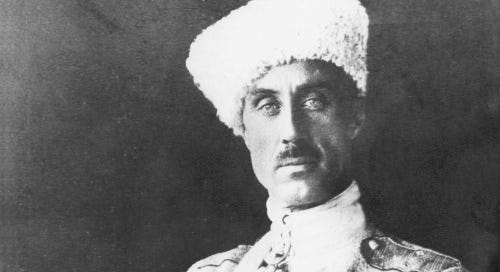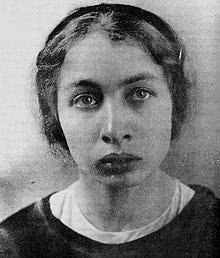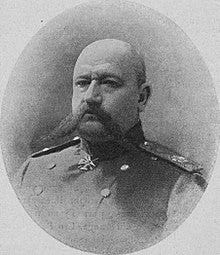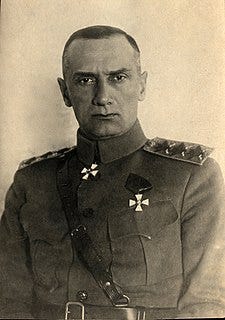Note: This article is part of a series.
The leading Bolshevik members of the 20th century, Vladimir Lenin (1817-1924) and Lev Davidovich Bronstein ‘Leon Trotsky’ (1879-1940), both believed that a worldwide revolution would inevitably occur, which it didn’t. This turned their focus to saving the revolution in Russia from defeat. Lenin faced two challenges to his authority, which made the process of consolidating the revolution both easier and more difficult. These battles are referred to as the Russian Civil War because the Bolsheviks fought both concurrently with the same army, strategies and general location.
It is more helpful, however, to consider this period as made up of two distinct threats. First, there was the internal threat of a Russian civil war where the Bolshevik forces (called the Reds) were confronted by many separate anti-Bolshevik forces (called the Whites and the Greens). Second, there was the external threat in 1918 and 1919 where several nations sent in troops in a bid to force Russia to rejoin the war and re-engage the Germans in battle on the Eastern Front.
The Communists were convinced of their ultimate victory both in Russia and throughout Europe. Zinoviev, a Bolshevik, exclaimed in May 1919:
‘Old Europe is rushing towards revolution at breakneck speed. In a twelve-month, we shall have forgotten that there was ever a struggle for Communism in Europe, for all Europe will be communist.’
The result of both threats was also the same. Led effectively by Lenin and Trotsky, the Bolsheviks, who now called themselves Communists, were forced to adopt dictatorial methods of discipline and control that became an integral part of the nature of the Communist Party, even after the Civil War had been won.
An entire book could be devoted to the Civil War itself. For example, Kiev, the capital of Ukraine, changed control 16 times during the war. In this article, I will provide a clear outline of the events and significance of this crucial period.
Attempted assassination of Lenin:
On the 30th of August 1918, a crucial event took place that directly changed the policies and approach of the Bolshevik government. Lenin had only been in power for 10 months. Despite the assassination of Michael Uritsky, the Head of the CHEKA in Petrograd, that morning by a Socialist Revolutionary student, Lenin continued his afternoon program in Moscow. He was to make two open-air speeches to the Russian public, accompanied only by his chauffer. After the second, he was approached by a group of women, one of whom held out her arm to push the crowd of workers away, while another, Fanny Kaplan, pulled out a revolver and shot Lenin three times.
Two shots hit Lenin: one in the left shoulder blade near to the collar bone, and the other more dangerously in the base of his neck. Bleeding profusely, Lenin demanded to be taken directly to the Kremlin as he feared being ambushed on the way to the hospital. He stubbornly walked up the stairs, refusing to be carried. The major problem was that there were only Bolshevik leaders and their families in the Kremlin and two surgeons only arrived in the hours of the following morning. Lenin immediately asked:
‘Is the end near? If it’s near tell me straight so that I don’t leave matters pending.’
Women in the Kremlin suggested sending out to get some lemons to disinfect the wounds. Lenin refused, fearing that the local grocer might not be politically reliable.
Doctors refused to operate as the bullet was close to Lenin’s spine and may have resulted in paralysis or death. From this point on, he suffered severe headaches and migraines. All the events following this need to be read in this light. The most significant outcome of the failed assassination was the direct introduction of a policy of Red Terror by the Bolshevik government. The shooting was direct proof to the government that counter-revolution was real, active and dangerous. Socialist Revolutionaries and Mensheviks became the tools of the class enemy. The policy of Red Terror was implemented to defeat enemies of the government and dominated the Bolshevik mentality during the Civil War that followed.
On the 1st of September 1918, a Bolshevik newspaper, Krasnaya Gazeta, summarised this new and radical approach:
‘We will turn our hearts into steel, which we will temper in the fire of suffering and the blood of fighters for freedom. We will make our hearts cruel, hard and immovable, so that no mercy will enter them, and so that they will not quiver at the sight of a sea of enemy blood. We will let loose the floodgates of that sea. Without mercy, without sparing, we will kill our enemies in scores of hundreds. Let them be thousands; let them drown themselves in their own blood. For the blood of Lenin… let there be floods of the blood of the bourgeois — more blood, as much as possible.’
Fanny Kaplan (1890-1918):
Fanny Kaplan was from the Ukraine, which had been sacrificed to the Germans in the Treaty of Brest-Litovsk. She was an anarchist and had been imprisoned for terrorism under the rule of Tsar Nicholas II. Sources differ as to whether she was linked to the Socialist Revolutionaries. After her attempted assassination attempt on Lenin, Kaplan’s Jewish background led to an increase of anti-Jewish sentiment and violence. She was executed three days later without either a trial or even a comment as to whether she had worked alone or as part of a conspiracy.
Whites, Greens and internal disssent:
It is indeed difficult to state exactly when the Civil War commenced. Internal dissent began as soon as the Bolsheviks had seized power in October 1917. As previously discussed, the Bolsheviks received open opposition from the Socialist Revolutionaries and other anti-Bolshevik movements. As early as December 1917, General Kornilov was gathering a volunteer army from the Don Cossack region to fight against the government.
The White Army:
The White armies comprised the traditional conservative forces in Russia during the Civil War (1917-1922). They were led by officers from the former Russian army and were supported by peasants, landowners, businessmen and ousted political groups like the Socialist Revolutionaries who wanted to defeat their new Soviet government. These powerful generals threatened from every direction. Although the following threats are listed separately for clarity, each attack overlapped and for more than three years provided a serious and constant opposition to the Soviet government.
September 1918: General Wrangel’s northern threat
The Socialist Revolutionaries established a government in the north, but it was overthrown by a military coup in September 1918 led by Baron and General, Pyotr Wrangel, who opposed any form of revolutionary, socialist government.
October 1919: General Yudenich’s north-western threat
General Yudenich led an army of 14,400 Russian soldiers who had been captured and then released by the Germans. Their biggest challenge to the reds was an attack on Petrograd in October 1919, but they were defeated by the Reds on the outskirts of the city. At the same time, General Denikin’s forces reached their closest point to Moscow before being defeated at Orel.
August 1918: Murder of the royal family
The royal family was murdered by local Bolsheviks to prevent them from being saved by the White armies.
1918-20: Admiral Kolchak’s eastern threat
Kolchak had been Admiral of the Black Sea Fleet during the First World War and his hatred of socialism led him to focus on establishing an anti-Bolshevik government in Siberia. He commanded a powerful army of 100,000 soldiers and was supplied with one million rifles and 700 field field guns by the Allies.
In March 1919 he advanced into Red territory along the Trans-Siberian Railway. An English periodical called the Annual Register, which sought to record the most significant events in each year, described Kolchak as being the most important of the anti-Bolshevik forces, who had ‘the support of the entire outside world’. However, Kolchak resigned in January 1920 after 80 per cent of his anti-Bolshevik peasant conscripts deserted. He was shot by the Red Army.
December 1917-20: General Denikin’s southern threat
Denikin was an old-fashioned nationalist who wanted to restore the monarchy. He commanded a maximum of 150,000 soldiers and advanced through Ukraine and Kiev close to Moscow. In March 1920 he handed over command of his White forces to General Wrangel.
In Red vs White II, we will discuss the Green armies, foreign intervention as a threat to the Bolshevik government and why the Bolsheviks won the Civil War.








